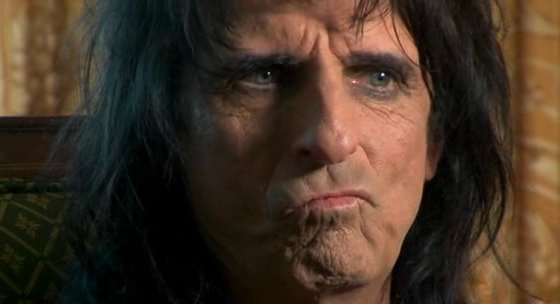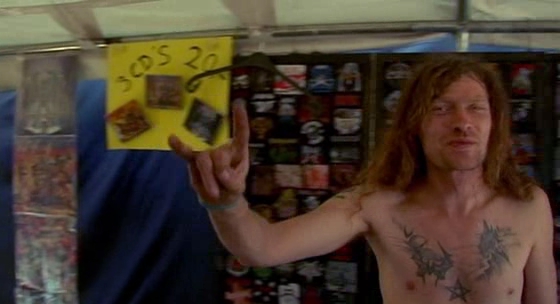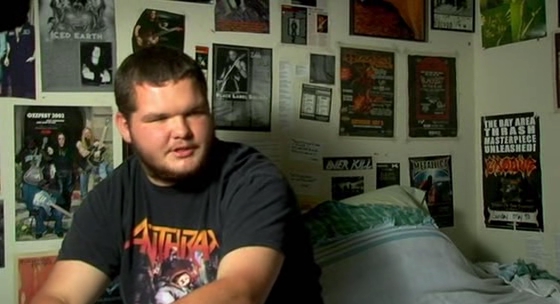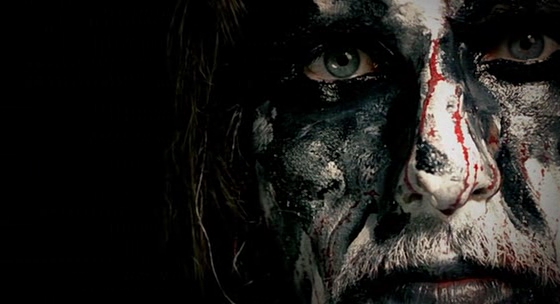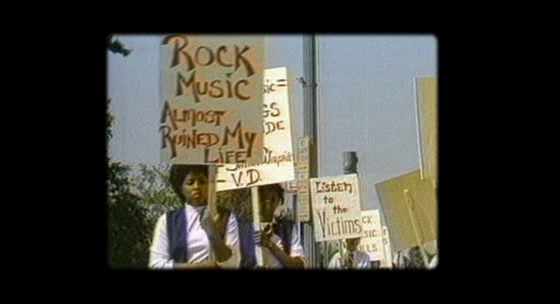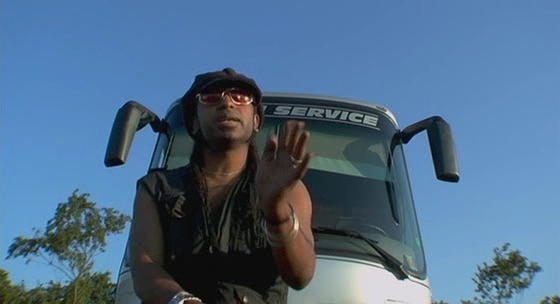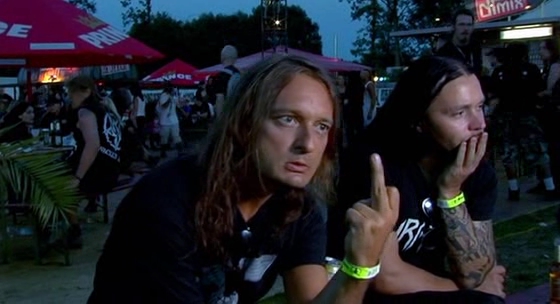|
Metal: A Headbangers Journey
|
A review grown out of proportions
|
||||||||||
Finally, metal gets its own serious contemplative theater-length movie instead of another shallow rockumentary or the usual 30-minute outside-perspective on all the outrageous extremes on the fringes of the scene. And rightfully so, being one of the biggest and most steady, though evolving, musical genres that has pulsed and breathed under the subsurface of popular culture for almost 35 years. A history with its own defining moments, innovators, mental patients running free, tragedies and celebrations. A happening strongly supported by faithful fans and a lot of dedicated participants, yet so belonging to those dark and obscure alleys of society's cities that quite a few people will either shy away from it or abruptly turn around in dismay at the first stroke on the guitar. As Rob Zombie aptly puts it during his interview: ?It's so fucking huge - yet some people don't even know it exists?. This describes quite accurately what I have always found to be fascinating about metal and I don't think I'm alone in this. Therefore, I'm delighted to welcome a movie that might provide an intelligent and unbiased glance into the world of tight leather pants, big hair, heavy metal drag queens, evil nihilists and gothic flitter mice.
While the larger part of the movie appears to maintain a descriptive nature, don't expect a purely objective assessment. The project is the initiative of anthropologist Sam Dunn, who declares at the very beginning of the documentary that he has been a die-hard metalhead from his teens, and that his goal is not to present a complete history of metal, but to deal with an issue that has kept him debating for years: why metal and its listeners have always been stereotyped, dismissed and condemned.
He starts with presenting a nice overview of what metal has to offer and tries to structure the story by classifying and presenting the main elements of the musical culture and its personae. And these personae always make for interesting, and sometimes relativizing, views; Tony Iommi (representing Black Sabbath as musical pioneers and not just invoking the image of a bunch of adolescent idiots, like Ozzy Osbourne) recounting the first description of his music as 'heavy metal', Dee Snider proclaiming that ?some doctors need to look into this? (tight pants and lingerie in glam/heavy metal) and Ronnie James Dio explaining the Italian origin of the 'devil horns'. Since these early performers were entertainers above all, we also stumble across a lot of hilarious moments, such as Dio taking the last piss at Gene Simmons, Alice Cooper mimicking Norwegian blackies and Dee recalling his insinuations of Tipper Gore being a latent sadomasochist. The frankness of a lot of these participants is quite invigorating; the glance at the impetuous roots and early developments of heavy music keenly counterweights wrought modern images of pseudo-Satanists/fascists or urban-attitude metalcore and nu-metal bands.
Less satisfying are the prominent contributions of Slipknot and Cannibal Corpse - I could think of a dozen other bands that would have represented modern and extreme metal ten times better (and where are influential musicians/producers like Dan Swan? or Peter T?gtgren?). On the other hand, considering the theme of the movie, these choices are obvious: Slipknot are involved because of their stage antics (the 'creepy' masks) and Cannibal Corpse because of their presumably shocking gore album covers. In general - aside from the real big names - the provocative are preferred to the popular. Amongst all thrash bands, only Slayer gets interviewed, Vince Neil of M?tley Cr?e is favoured to his peers from Kiss, Poison and Van Halen and in the realms of the cold and grim we meet Ghaal of Gorgoroth, Necrobutcher of Mayhem (and how?) and J?rn Tunsberg of Hades (accomplice of Varg Vikernes, Burzum, in the arson of Osane church), instead of more significant progressors like Enslaved, Emperor, Immortal and Darkthrone. Sadly, these choices do not always lead to astounding insights; especially Corey Taylor of Slipknot/Stone Sour reaches lonely heights with declaring the metal scene as the ?...the last bastion of real masculinity in western society ... one of the few places to go and do dumb shit? or proclaiming that ?...you cannot envisage Black Sabbath without seeing at least one upside-down cross?. Really? Show me one please. Let's just say I'd wear a mask too if I made such a series of stupid comments in a row.
Individual blabbering aside, the narrative journey through the world of metal is nice to watch; a lot of the essential topics are addressed and the collage of different scenes and interviews is skillfully edited. The general tone of a serious and intelligible assessment is convincing and surely provides a lot of devotees with a nice trip down to nostalgia lane.
My biggest gripe with the themes and the subjects discussed in relation to the main subject matter however is that I find it all a bit indiscriminate. While some statements are treated with a certain reservation, the main tendency is one of convergence. In an inquiry that tries to find the rationale behind stereotypification, generalisation isn't really a strong move. Of course it is impossible to cover every little facet of metal culture in detail but Dunn could have left a little more space amplifying diversity instead of strengthening clich?s; deconstructing these classic images could result in a better understanding of the congregation that constitutes the heavy music audience and their whereabouts, ultimately providing fertile ground for far more interesting questions about modern culture. |
For example, numerous statements are made about the grave circumstances a lot of metalheads grew up with, virtually insinuating metal is the corollary of being a social outcast. In fact, it's a bit more complicated than that. A majority of the black metal practitioners reside in a rich environment, craving larger concepts than escaping crime or a mind-numbing industrial environment. People don't automatically slip into spandex pants and bullet-belts because of monotony (or rather kill themselves instead of using their imagination - another historical line from Slipknots' front man). Not all fans belong to the 'disaffected'; a large part of the audience actually consists of well-educated, quite sophisticated and relatively prosperous adolescents, not in the least represented by Dunn himself. Tribal attitude? A lot of the musicians claim individualism as the highest virtue of all, just read the lyrics. And statements about metal as a macho-culture contrast strongly with featured artists and supporters, I mean, take a good look at, for example, Iommi, Dio or Ishahn - they aren't quite the embodiment of masculinity, now are they?
If you ask me, the headbanging crowd is rather heterogeneous and, while sharing mutual and often clearly-defined traits, all associate themselves with some and definitely not all of the general ideas and/or behavioral aspects of the metal scene. Most of the fans are highly interested in fantasy, occultism and (anti-)religious concepts, though a lot of 80's as well as modern metal bands are happy to limit themselves to uncomplicated social concepts. A lot of the fans like the sound of heavy distorted guitars but compare Malmsteen and Ildjarn. Also a lot of the presumably typical situations (hangover festivals, anyone?) fit other musical cultures, such as rock or punk, as easily as they fit metal.
So while Dunn seeks common elements in all these different aspects of the metal scene, drawing a charming aesthetic picture in the process, the result leans towards a fairly static and clearly defined portrait that doesn't relate well to all who feel associated. This is a little dissatisfying, since - and here I'll just toss in my own two cents - the broadest description that encompasses almost all metal bands/fans seems to be a strong sense of non-conformism. Not just anti-social, not merely disappointed in society, but rather a certain tendency of antagonism and resistance to a larger whole. People do not simply become a product of their environment but actually play an active role in shaping it. Rebellion, for whatever reason, lies more at the core of this music than being lonely, weird or outcast. And the agitation is not limited to larger social and political issues; significantly, phases of major development in metal are generally accompanied with mutinous sentiments, if not pure animosity, directed towards established artists. Hence, with 'dissatisfying' I mean failing to recognize a fundamental recurring contradiction within metal culture: the desire for rebellion is often cast into strong archetypes, which are bound to become the object of criticism themselves eventually. In this respect, metal culture could be described as something that is continuously defined, deconstructed and redefined, its traits and conduct, like with any artistic movement, organically evolving along the way. This cycle - a structural principle finely missed by the documentary - explains more accurately common sentiments and associated personalities in metal culture and could be an interesting point of departure for further questions about the reflection of social, psychological and ideological concepts of developing modern societies.
The gravitation towards a plain depiction in the defensive plea of Sam Dunn is understandable however, since it seems to serve a clear purpose. In the light of allegation his strategy is to present a relatively innocent, harmless and sound rendering of metal culture, meaning to convince critics that metalheads are not just young, angry maniacs lost in society, but actually embody a strong movement with its own fair and passable ethics and an extensive cultural background (which explains his own condemnation of Norwegian black metal calamities, which is almost as 'pigeonholing' as can possibly be?). The aspiration to create such an uncomplicated and endearing picture might have been stimulated by the social and political tenets of his own habitat. The fact that, aside from the lack of typological and chronological differentiation, geographical distinctions are almost completely ignored hints at the possibility that Dunn is first and foremost responding to a specific North-American view of things. While in Western Europe, metal culture meets (and has met) similar biased rejection, the confrontation commonly takes place at the high school courtyard, alongside the occasional attack launched by a socially detached cleric with too much spare time. In the U.S. however, the debate ensued broadly on a national and public level, and at a certain point seriously threatened to ban metal music from radio and television, if not completely. So 'stereotyping', 'dismissing' and 'condemning' in that part of the world actually refers to putting the party-animals of Twisted Sister, the celebrated gay-hero Rob Halford, and, for all sakes, the sweet'n'sly studs of Whitesnake into the defendant's bench on the premises of ridiculous charges. Justifiably, a country with such conservative and fundamentalist social sensibilities is surely in need of a solacing story...
Concluding, I'd say that Metal - A Headbanger's Journey is primarily an enthusiast's explanation amply provided with interesting ideas, rather than a precise dissection of the various themes and threads that run through the different sections and layers of the metal communities. However, alongside this statement I must definitely emphasize that, notwithstanding all serious comment above, the movie is absolutely appealing and engaging, and consequently required for all fans of heavy music. This should be seen and I personally just hope that it will provoke further discussion in its course. (Jitte Waagen)
[As I wrote down the last words of this review I was able to lay my hands on the Norwegian Black Metal special, featured among the extras on the DVDs. The 20-minute documentary is made as a response to criticism coming from the Norwegian metal scene about the shallow and one-sided presentation of black metal in MAHJ. Herein the discussion is actually taken a step further and therefore absolutely recommendable to take a look at as well.] |

